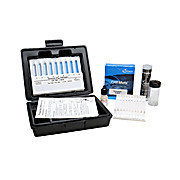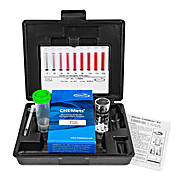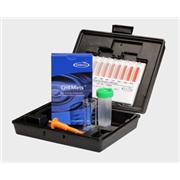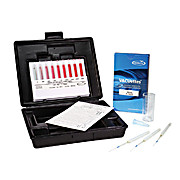CHEMetrics Water Quality
-
Ozone CHEMets Kit
CHEMetricsOzone is a strong oxidizing agent and is used as an alternative to chlorine as a biocide in the disinfection of drinking water. Ozone is used to remove odor, decolorize, and to control algae and other aquatic growths. Ozone is also used in various disinfectant and sterilization processes in…
-
Hydrogen peroxide is a strong oxidizing agent with a variety of uses. Applications include the treating of industrial effluents and domestic waste and serving as a disinfectant in aseptic packaging. For the food and beverage industry, CHEMetrics Hydrogen Peroxide CHEMets® and…
-
Ammonia HBA Test Kit
CHEMetricsLow-level ammonia nitrogen may be naturally present in water as a result of the biological decay of plant and animal matter. Higher concentrations in surface waters can indicate contamination from waste treatment facilities, raw sewage, industrial effluents (particularly from petroleum refineries),…
-
DEHA Titrets Kit
CHEMetricsDissolved oxygen in boiler system water causes corrosion and pitting of metal surfaces, which can lead to boiler inefficiency, equipment failure, and system downtime. DEHA (N,N-Diethylhydroxylamine) is added to boiler system water as an oxygen scavenger to keep the dissolved oxygen levels as low as…
-
Kit comes in a plastic case and contains everything needed to perform 30 tests (except distilled water): Refill, Low and High Range Comparators, dilutor snapper cup, micro test tube, and instructions. Range: 0-30 & 30-300 ppm MDL: 5 ppm Method: Direct Nesslerization …
-
Sulfite (free) Titrets® Titration Cells
CHEMetricsSulfite is not usually present in surface waters. If sulfite is discharged in effluents or from domestic wastewaters, it readily oxidizes to form sulfate. Sodium sulfite is the most common form of sulfite and is an excellent reducing agent with applications as an oxygen scavenger. Sulfite…
-
Sulfide Vacu-vials® Kits
CHEMetricsSulfides are naturally present in ground waters as a result of leaching from sulfur-containing mineral deposits. Surface waters do not usually contain high sulfide concentrations. Sulfides result from the decomposition of organic matter, from bacterial sulfate reduction under anaerobic conditions…
-
Sulfide VACUettes® Kits
CHEMetricsSulfides are naturally present in ground waters as a result of leaching from sulfur-containing mineral deposits. Surface waters do not usually contain high sulfide concentrations. Sulfides result from the decomposition of organic matter, from bacterial sulfate reduction under anaerobic conditions…
-
Phosphate CHEMets® Kits
CHEMetricsPhosphorus occurs naturally in rock formations in the earth's crust, usually as phosphate. High phosphate concentrations in surface waters may indicate fertilizer runoff, domestic waste discharge, or the presence of industrial effluents or detergents. Although phosphates from these sources are…
-
Molybdate CHEMets Kit, Range: 20-200 ppm
CHEMetricsMolybdate is used throughout the industrial water treatment and power generation industries as a corrosion inhibitor in both open- and closed-loop cooling water systems. In solution, molybdate anions complex with oxidized iron to form a protective film of molybdate and ferric-oxide. Molybdate is…
-
Method Dissolved carbon dioxide (CO2) is naturally present as a result of animal respiration, the decay of organic matter, and the decomposition of certain minerals. It is the major source of acidity in unpolluted water samples. Surface waters typically contain less than 10 ppm…
-
Hardness is a measure of the mineral content of water. Calcium and magnesium are the most common minerals that contribute to hardness. Hard water causes scaling in boilers and other industrial equipment, and diminishes the effectiveness of soaps and detergents. The EDTA Method (Total) …
-
Hydrazine VACUettes Kit, Range: 0-25 ppm
CHEMetricsHydrazine is a powerful reducing agent that is used in various chemical processes and in boiler water as an oxygen scavenger. To control corrosion, residual hydrazine typically is maintained in the 0.05 to 0.1 mg/L range. Higher levels may be used to guard against corrosion when the boiler is out…
-
Because of its strong oxidizing properties, chlorine is an excellent biocide used to treat potable waters, municipal wastes, and swimming pools. When used to treat potable water, chlorine helps alleviate the adverse effects of iron, manganese, ammonia, and sulfide. The Maximum Residual Disinfectant…
-
Hydrazine VACUettes Kit, Range: 0-12.5 ppm
CHEMetricsHydrazine is a powerful reducing agent that is used in various chemical processes and in boiler water as an oxygen scavenger. To control corrosion, residual hydrazine typically is maintained in the 0.05 to 0.1 mg/L range. Higher levels may be used to guard against corrosion when the boiler is out…
-
Nitrate CHEMets Kit, Range: 0-225 ppm
CHEMetricsNitrate is the most completely oxidized form of nitrogen. It is formed during the final stages of biological decomposition, either in wastewater treatment facilities or in natural water supplies. Low-level nitrate concentrations may be present in natural waters. However, a Maximum Contaminant Level…
-
Hydrogen Peroxide Titrets Kit
CHEMetricsHydrogen peroxide is a strong oxidizing agent with a variety of uses. Applications include the treating of industrial effluents and domestic waste and serving as a disinfectant in aseptic packaging. The Ceric Sulfate Titrimetric Method Reference: Developed by CHEMetrics …
-
Kit comes in a plastic case and contains everything needed to perform 30 tests (except distilled water): Refill, Low and High Range Comparators, dilutor snapper cup, micro test tube, and instructions. Range: 0-60 & 60-600 ppm MDL: 10 ppm Method: Direct Nesslerization …
-
Nitrate CHEMets Kit, Range: 0-2700 ppm
CHEMetricsNitrate is the most completely oxidized form of nitrogen. It is formed during the final stages of biological decomposition, either in wastewater treatment facilities or in natural water supplies. Low-level nitrate concentrations may be present in natural waters. However, a Maximum Contaminant Level…
-
Phenols CHEMets® Kits
CHEMetricsPhenol (hydroxybenzene) is the simplest of a group of similar organic chemicals, which includes cresols, xylenols, and catechols. Phenol itself is a common ingredient of disinfectants. In drinking water, low-level phenolic concentrations impart a foul taste and odor, especially upon chlorination.…
-
Hydrogen peroxide is a strong oxidizing agent with a variety of uses. Applications include the treating of industrial effluents and domestic waste and serving as a disinfectant in aseptic packaging. The Ferric Thiocyanate Method Reference: D. F. Boltz and J. A. Howell, eds.,…
-
WARNING! This product can expose you to chemicals including ethylene glycol, which is known to the State of California to cause birth defects or other reproductive harm. For more information go to www.P65Warnings.ca.gov .
-
Molybdate CHEMets Kit, Range: 0-7 ppm
CHEMetricsMolybdate is used throughout the industrial water treatment and power generation industries as a corrosion inhibitor in both open- and closed-loop cooling water systems. In solution, molybdate anions complex with oxidized iron to form a protective film of molybdate and ferric-oxide. Molybdate is…
-
Phenols VACUettes® Kits
CHEMetricsPhenol (hydroxybenzene) is the simplest of a group of similar organic chemicals, which includes cresols, xylenols, and catechols. Phenol itself is a common ingredient of disinfectants. In drinking water, low-level phenolic concentrations impart a foul taste and odor, especially upon chlorination.…
-
Nitrate Vacu-vials Kit, Range: 0-7.50 ppm
CHEMetricsNitrate is the most completely oxidized form of nitrogen. It is formed during the final stages of biological decomposition, either in wastewater treatment facilities or in natural water supplies. Low-level nitrate concentrations may be present in natural waters. However, a Maximum Contaminant Level…
-
Iron in Brine CHEMets Kit
CHEMetricsIron is present in nature in the form of its oxides, or in combination with silicon or sulfur. The soluble iron content of surface waters rarely exceeds 1 mg/L, while ground waters often contain higher concentrations. The National Secondary Drinking Water Standard for iron is 0.3 mg/L, as iron…
-
Nitrite CHEMets Kit, Range: 0-2.5 ppm
CHEMetricsNitrite, an intermediate in the nitrogen cycle, is formed during the decomposition of organic matter but readily oxidizes to form nitrate. These processes occur in wastewater treatment plants, water distribution systems, and natural waters. Nitrites are useful as corrosion inhibitors,…
-
Test Kit
CHEMetricsThe CHEMetrics peracetic acid CHEMets kit and peracetic acid comparator are used to determine various levels of peracetic acid in liquids. These are easy to use and ensure accurate testing. Application: For the Analysis of Peracetic Acid
-
Hydrazine VACUettes Kit, Range: 0-50 ppm
CHEMetricsHydrazine is a powerful reducing agent that is used in various chemical processes and in boiler water as an oxygen scavenger. To control corrosion, residual hydrazine typically is maintained in the 0.05 to 0.1 mg/L range. Higher levels may be used to guard against corrosion when the boiler is out…
-
Because of its strong oxidizing properties, chlorine is an excellent biocide used to treat potable waters, municipal wastes, and swimming pools. When used to treat potable water, chlorine helps alleviate the adverse effects of iron, manganese, ammonia, and sulfide. The Maximum Residual Disinfectant…
-
Chlorine Dioxide CHEMets Kit
CHEMetricsChlorine dioxide is used as an oxidizing microbiocide in industrial cooling water treatment, the dairy industry, the meat industry, and many other food and beverage industry applications. It is used as a bleaching agent in the pulp and paper industry, and as a disinfectant in municipal water…
-
Filming Amine (aliphatic amine) CHEMets Kit
CHEMetricsKit comes in a cardboard box and contains everything needed to perform 20 tests: Refill, Comparator, reaction tube with lid, tip breaking tool, and instructions. Filming amines are fed continuously into boiler feedwater to protect metal surface from corrosion cuased by dissolved oxygen and…



































